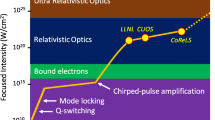2
CrO4 are irradiated by a KrF excimer laser (λ=248 nm, FWHM=24 ns) with moderate energy density (up to 100 MW/cm2) below the plasma-formation threshold. The ablation process, including the vapor-cavity formation and the acoustic-wave propagation is visualized by laser-flash photography. The ablation thresholds are determined by measuring the generated pressure transients and vapor-phase kinetics using a broadband piezoelectric pressure transducer and a simultaneous optical-transmission probe, respectively. The mechanisms of liquid ablation and acoustic-pulse generation are investigated based on the thermoelastic behavior of the liquid medium and the evaporation dynamics. A numerical model is proposed to describe the explosive-vaporization process at high laser fluences. The computation results are compared with the experiment.
In short-pulse heating, ablation can be initiated at low laser fluences by the tensile component of the thermoelastic stress without a significant increase in the liquid temperature. On the other hand, if the heating rate is rapid enough to achieve a high degree of superheating of the liquid, the abrupt increase of the homogeneous-bubble-nucleation rate leads to explosive vaporization, which then plays the major role in the ablation dynamics. The pressure transient in the liquid is generated thermoelastically at low laser fluences, but the contribution of the vapor-phase expansion and/or the recoil momentum exerted by the ablation plume becomes significant at high laser fluences. Shock waves are formed in the ambient air in the case of explosive vaporization. The propagation of these wave fronts is in good agreement with the numerical-computation results.
Similar content being viewed by others
Author information
Authors and Affiliations
Additional information
Received: 8 February 1998/Accepted: 10 February 1998
Rights and permissions
About this article
Cite this article
Kim, D., Ye, M. & Grigoropoulos, C. Pulsed laser-induced ablation of absorbing liquids and acoustic-transient generation . Appl Phys A 67, 169–181 (1998). https://doi.org/10.1007/s003390050756
Issue Date:
DOI: https://doi.org/10.1007/s003390050756




